|
|
|
Sort Order |
|
|
|
Items / Page
|
|
|
|
|
|
|
| Srl | Item |
| 1 |
ID:
188328
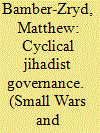

|
|
|
|
|
| Summary/Abstract |
The rise and decline of the Islamic State’s (IS) caliphate between 2014 and 2018 have garnered significant policy and academic attention. Explanations for the group’s territorial demise have focussed on its internal group dynamics and external conflict processes. Although both explanations are valid, I adopt a historical approach to show that IS’s caliphate was just one cycle in a two-decade history of governance activity. IS has undertaken three governance cycles composed of phases of insurgency, gaining territory, establishing institutions, and losing territory. After each governance cycle, IS engaged in a process of critical self-reflection and adapted its governance strategy significantly. This resulted in a progressive history in which, with each cycle, IS governed greater amounts of territory, through more complex institutions, for a longer period of time. This article is based on fieldwork interviews conducted with both IS members and civilians who lived under IS control in Iraq, Lebanon, Syria, and Turkey, as well as archival research on IS historical and contemporary governing documents.
|
|
|
|
|
|
|
|
|
|
|
|
|
|
|
|
| 2 |
ID:
188330


|
|
|
|
|
| Summary/Abstract |
Since the commencement of the counterinsurgency fight against Boko Haram, the Nigerian Army has been faced with internal crises, such as corruption, poor welfare conditions for soldiers, among others, which have undermined efforts at defeating the insurgents. Military authorities have both down-played and denied these internal challenges. The result is frequent mutiny by soldiers. This paper examines the drivers, dynamics, and responses to mutiny within the Nigeria Army in the context of ongoing counterinsurgency (COIN) operation in the northeast. Anchored on the analytical framework of Tactical Communication Strategy, the paper contends that resort to mutiny is a strategy by soldiers to open up dialogue with the military authority and communicate to the public the internal factors that account for battlefield failures. Hence, the paper recommends that soldiers’ welfare be given high priority rather than resort to punitive measures.
|
|
|
|
|
|
|
|
|
|
|
|
|
|
|
|
| 3 |
ID:
188326
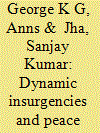

|
|
|
|
|
| Summary/Abstract |
The intended purpose of this paper is to examine the viability of political resolution as a counterinsurgency strategy. We have selected numerous political negotiation processes between insurgents and government of India in general and Mizoram in particular. The political resolution with Mizo National Front is considered as the most successful counterinsurgency operation in India. Placing this as a model, the government of India employed the strategy of negotiation with various other insurgent groups. The degree of success in Mizoram was not replicated in other insurgency theatres. This was analyzed with the help of a comparative study with other insurgent groups in India, particularly within the state of Assam. It is found that the model of Mizo resolution has been influencing the peace process that came later. And also the strategy of negotiation has been evolving into incorporating civil society groups as signatories to the final peace settlement signed between insurgents and government. This analysis of the peace process is also based on the conceptualization developed from various authors.
|
|
|
|
|
|
|
|
|
|
|
|
|
|
|
|
| 4 |
ID:
188327
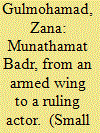

|
|
|
|
|
| Summary/Abstract |
Badr has become a key Shia socio-political-armed organisation in Iraq and has revamped its political and organisational structure. Previously, it was an Iran based and designed Iraqi Shia opposition force, the armed wing of the Supreme Council for the Islamic Revolution in Iraq. Post-2003 it transformed into an incohesive political organisation with an armed wing and engaged in electoral politics. Badr has influenced the state’s apparatus and played a key role in the Popular Mobilisation Forces’ campaign against the Islamic State in Iraq. Primary resources, including interviews, Badr’s media and platforms and publications explain Badr’s approaches and decentralised structure.
|
|
|
|
|
|
|
|
|
|
|
|
|
|
|
|
| 5 |
ID:
188331
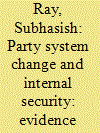

|
|
|
|
|
| Summary/Abstract |
Has the consolidation of the Hindu nationalist Bharatiya Janata Party (BJP) as the dominant party at the national level since the 2014 Lok Sabha election affected internal security outcomes in India? This question assumes particular significance because of the primacy accorded to the use of force in the BJP’s counter-insurgency (COIN) strategy. Using sub-national data on insurgency-related fatalities from 2005–2021, I examine whether states where the BJP received the largest share of votes in the 2014 Lok Sabha election subsequently experienced any significant changes in the pattern of fatalities. Implementing a difference-in-difference econometric specification, I show that the BJP states experienced a relatively sharper decline in security force fatalities from pre-2014 compared to non-BJP states. However, there was no such effect on civilian fatalities or the total number of insurgency-related incidents. Taken together, these findings show that the greater thrust towards militarism in COIN strategy under the BJP, has, paradoxically, increased the security of military/police personnel involved in COIN operations, without commensurate changes in the security of those whom they are mandated to defend.
|
|
|
|
|
|
|
|
|
|
|
|
|
|
|
|
| 6 |
ID:
188332
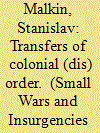

|
|
|
|
|
| Summary/Abstract |
The article analyses the gaps and ties betweenthe doctrine and theory, in contrast with the practice, of countering subversive movements in the British Empire during the Interbellum. Contradictions between security services led to the articulation and promotion of different models of counterinsurgency. The research contains an analysis of the guerrilla warfare concept’ evolution within the military thought, through the second Boer war, Irish warof Independence and the second Arab rising in Palestine, reflecting different thoughts on interrelated problems of the ‘revolutionary movements’ and ‘sub-war’ after the Great War. Particular attentionis paid to military and political incentives and constrains of the counterinsurgency doctrine, reflecting the bureaucratic logic that stood behind the implementation of the guerrilla warfare concept at the levels of doctrine and theory in the context of the systemic crisis of empire and the growth of external pressure over the questions of the imperial defense and self-determination. Conflicting coexistence of internal security models tested within the British Empire during the Interbellum is observed in the conclusion,as well as perspectives of transfers of colonial (dis)order in front of the ‘sub-war’, as it was understood among the military circles through the prism of the guerrilla warfare concept.
|
|
|
|
|
|
|
|
|
|
|
|
|
|
|
|
| 7 |
ID:
188329
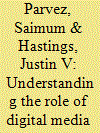

|
|
|
|
|
| Summary/Abstract |
Notwithstanding the discernable participation of women in terrorist groups, empirical research on women in terrorism is very scant in Bangladesh. To fill this gap, our article examines women’s involvement in terrorism by analyzing the life stories of dozens of Bangladeshi women terrorists. We use a terrorist lifecycle approach to understand the role of digital media in female participation, particularly in terms of when in the lifecycle digital media becomes important, and in terms of how digital media interacts with other factors to shape women’s involvement in terrorist organizations. After analyzing female profiles and their socio-demographic traits, we provide an in-depth analysis of three female terrorist lifecycles. An analysis of the profiles of Bangladeshi terrorists who use digital media reveals that women were more likely to use digital media than men in the recruitment phase. The in-depth case studies of three female terrorist profiles find that multiple and different factors impact their terrorist life cycles. Social networks – families and friends – typically play a role in individuals’ decision to become involved and further engagement in terrorism. Specifically, digital media allows women to expand their social interactions beyond what is possible in person, thus allowing for virtual pathways into terrorism.
|
|
|
|
|
|
|
|
|
|
|
|
|
|
|
|
|
|
|
|
|